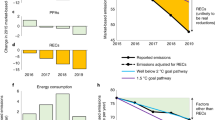Abstract
New Source Review (NSR) is a Clean Air Act regulation that requires electric utilities to meet emission standards when making modifications to existing power plants. The regulation increases the cost of replacing worn out parts, and limits the firm’s scope of potential capital investments. Such restrictions may lead to greater retirements and lower utilization, adversely affecting profits. Prior to the 2000 presidential election, investors expected Bush to have a narrower interpretation of NSR than Gore. Therefore, we use changes in stock prices to estimate the effect on profits of differences in NSR policy. Our results indicate that investors expected the average boiler to be $38 million more valuable under the Bush administration. Over the boilers’ lifetimes, the additional utilization will have increased emissions by 19 million tons of sulfur dioxide, 5.9 million tons of nitrogen oxides and 980 million tons of carbon dioxide, relative to natural gas generation.
Similar content being viewed by others
References
Bellas A (1998). Empirical evidence of advances in scrubber technology. Resour Energy Econ 20(4): 327–343
Boehmer E, Musumeci J and Poulsen AB (1991). Event-study methodology under conditions of event-induced variance. J Financ Econ 30: 253–272
Bushnell J, Wolfram C (2007) The economic effects of vintage-differentiated regulations: the case of new source review. Center for the Study of Energy Markets. Paper CSEMWP-157
Electric Utility Week (April 24, 2000) States meet to eye reform for air program; political edge criticized
Energy Information Administration (2004) Electric power annual. Energy Information Administration, Washington DC
Fabrizio K, Rose N and Wolfram C (2007). Do markets reduce costs? Assessing the impact of regulatory restructuring on U.S. Electric Generation Efficiency. Am Econ Rev 97(4): 1250–1277
Fama EF and French KR (1993). Common risk factors in the returns on stocks and bonds. J Financ Econ 33: 3–56
Hughes P (2006). Do EPA defendenants prefer republicans? Evidence from the 2000 election. Econ Inq 44(3): 579–585
Inside (2000) OMB clash over mercury controls on power plants. 11(25). http://insideepa.com/. Cited 10 June 2006
Keohane NO, Mansur ET, Voynov A (2006) Averting enforcement: strategic response to the threat of environmental regulation. NBER working paper 13512, Mimeo
Knight B (2006). Are policy platforms capitalized into equity prices? Evidence from the Bush/Gore 2000 election. J Public Econ 90: 751–773
Linn J (2006) Stock prices and the cost of environmental regulation. AEI-Brookings Related Publication 06-16
List J, Millimet D, McHone W (2004) The unintended disincentive in the clean air act. Adv Econ Anal Policy 4(2), Article 2
MacKinlay C (1997). Event studies in economics and finance. J Econ Lit 35: 13–39
Maloney M and Brady G (1988). Capital turnover and marketable pollution rights. J Law Econ 31(1): 203–226
National Academy of Public Administration (2003) A breath of fresh air: reviving the new source review program
Salinger M (1992). Standard errors in event studies. J Financ Quant Anal 27: 39–53
Stanton T (1993). Capacity utilization and new source bias: evidence from the US Electric Power Industry. Energy Econ 15(1): 57–60
Stavins R (2005) The effects of vintage-differentiated environmental regulation. RFF Discussion Paper 05-12
United States Department of Justice (November 3, 1999) U.S. sues electric utilities in unprecedented action to enforce the clean air act. Press release no. 524
United States. Energy Information Administration (2000) The changing structure of the Electric Power Industry: an update. Energy Information Administration, Washington DC.
United States Environmental Protection Agency (2004) IPM documentation report. Available at: http://www.epa.gov/airmarkets/epa-ipm/
Author information
Authors and Affiliations
Corresponding author
Rights and permissions
About this article
Cite this article
Lange, I., Linn, J. Bush v. Gore and the Effect of New Source Review on Power Plant Emissions. Environ Resource Econ 40, 571–591 (2008). https://doi.org/10.1007/s10640-007-9170-z
Received:
Accepted:
Published:
Issue Date:
DOI: https://doi.org/10.1007/s10640-007-9170-z




